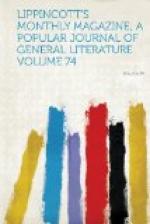Hurry, impatience and a worship of crude thought are characteristics of our present American life. Hunt is one of us. If these faults mark and mar his work, they show him also to be a child of the time. His quick sympathies are caught by the wayside and somewhat frayed out among his fellows; but nevertheless one essential of a great painter, that of Verity, will be accorded to him after an examination of the pictures we have mentioned.
But truth, character, skill, the many gifts and great labor which must unite to lead an artist to the foot of his shadowy, sun-crowned mountain, can then carry him no step farther unless ideal Beauty join him, and he comprehend her nature and follow to her height. Again we quote from Charles Blanc—for why should we rewrite what he says so ably?—“All the germs of beauty are in Nature, but it belongs to the spirit of man alone to disengage them. When Nature is beautiful, the painter knows that she is beautiful, but Nature knows nothing of it. Thus beauty exists only on the condition of being understood—that is to say, of receiving a second life in the human thought. Art has something else to do than to copy Nature exactly: it must penetrate into the spirit of things, it must evoke the soul of its hero. It can then not only rival Nature, but surpass her. What is indeed the superiority of Nature? It is the life which animates all her forms. But man possesses a treasure which Nature does not possess—thought. Now thought is more than life, for it is life at its highest power, life in its glory. Man can then contest with Nature by manifesting thought in the forms of art, as Nature manifests life in her forms. In this sense the philosopher Hegel was able to say that the creations of art were truer than the phenomena of the physical world and the realities of history.”
Now, thought in the soul of the true artist for ever labors to evolve the beautiful. This is what the thought of a picture means to him—how to express beauty, which he finds underlying even the imperfect individual of Nature’s decaying birth. To the high insight this is always discernible. None are so fallen that some ray of God’s light may not touch them, and this possibility, the faith in light for ever, radiates from the spirit of the artist, and renders him a messenger of joy. No immortal works have bloomed in despondency: they may have taken root in the slime of the earth, but they have blossomed into lilies.
We call this divine power to discern beauty in every manifestation of the Deity, imagination. As it expresses itself in painting, it is so closely allied with what is highest and holiest in our natures that painting has come to be esteemed a Christian art, as contrasted in its development subsequent to the Christian era with the less human works of sculpture. “Christianity came, and instead of physical beauty substituted moral beauty, infinitely preferring the expression of the




